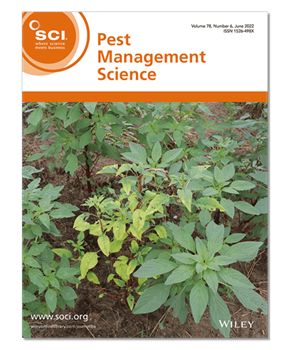Effects of nicotinic acetylcholine receptor subunit deletion mutants on insecticide susceptibility and fitness in Drosophila melanogaster
Yan-Chao Zhang, Xin-Guo Pei, Zhi-Tao Yu, Yang Gao, Li-Xiang Wang, Ning Zhang, Xin-Yu Song, Shun-Fan Wu, Cong-Fen Gao
To read and cite the full paper, please visit:
doi.org/10.1002/ps.6992
First published: 16 May 2022
WHAT'S IT ABOUT?
Many widely used commercial insecticides target specific neurotransmitter receptors in pests called nicotinic acetylcholine receptors (nAChRs). Over the years, resistance to these insecticides has evolved, diminishing their effectiveness. nAChRs consist of five subunits, and to improve pest management strategies it is necessary to better understand the interaction of insecticides with these subunits.
Researchers at Nanjing Agricultural University, Nanjing, China used fruit flies (Drosophila melanogaster) to investigate the susceptibility of different subunit deletion mutants to four classes of insecticide, and to assess the fitness costs of subunit deletions on the flies.
Results indicate specific subunits that may be the target sites of different insecticides. For example, a class of insecticides called spinosyns target the subunit α6. Analysis of the effect of knocking-out the different subunits on fitness characteristics of the flies, such as longevity, reproductivity and climbing ability, also revealed a low cost to fitness associated with loss of function of subunit α6.
Taken together, these factors may have accelerated the evolution of resistance to spinosyns. The new insights provided in this study contribute to the understanding of receptor-insecticide interactions, which can aid development of sustainable pest management strategies.
From the editor of Pest Management Science

Dr Stephen O Duke
Adjunct Research Professor, Thad Cochran Research Center
National Center for Natural Products Research, The University of Mississippi
Pest Management Science covers broad range of topics related to pest management, including pest biology, pesticide chemistry, mode of action of pesticides, pesticide formulation, application technology of pesticides, pesticide resistance, environmental fate and toxicology of pesticides, sociology and economics of pest management, integrated pest management, non-chemical pest management, and pest biocontrol. The highlighted paper is on the mechanism of resistance of the fruit fly to a category of insecticides that target a certain neurotransmitter receptor (nAChR) in insects. The nAChR is perhaps the most complex insecticide target site because of the many potential subunits and the large number of potential combinations. The Zhang et al. study was able to examine the function of all 10 nAChR subunits against a range of nAChR-acting insecticides, providing a far better understanding of the role of each subunit in the action of each insecticide.
ABSTRACT
Background: Nicotinic acetylcholine receptors (nAChRs) are major excitatory neurotransmitter receptors in insects and also the target site for many insecticides. Unfortunately, the effectiveness of these insecticides is diminishing as a consequence of the evolution of insecticide resistance. Further exploration of insecticide targets is important to sustainable pest management.
Result: In order to validate the role of nAChR subunits in insecticide susceptibility and test whether the subunit's absence imposes the fitness cost on insects, we determined the susceptibility of eight nAChR subunit deletion mutants of Drosophila melanogaster to nine insecticides. These findings highlighted the specific resistance of the Dα6 deletion mutant to spinosyns. Although triflumezopyrim, dinotefuran and imidacloprid are competitive modulators of nAChRs, differences in susceptibility of the insect with different deletion mutants suggested that the target sites of these three insecticides do not overlap completely. Mutants showed decreased susceptibility to insecticides, accompanied by a reduction in fitness. The number of eggs produced by Dα1attP, Dα2attP, Dβ2attP and Dβ3attP females was significantly lesser than that of the vas-Cas9 strain as the control. In addition, adults of Dα2attP, Dα3attP, and Dα7attP strains showed lower climbing performance. Meanwhile, males of Dα3attP, Dα5attP, Dβ2attP and Dβ3attP and females of Dβ2attP showed significantly shorter longevity than those of the vas-Cas9 strain.
Conclusion: This study provides new insights into the interactions of different insecticides with different nAChRs subunit in D. melanogaster as a research model, it could help better understand such interaction in agricultural pests whose genetic manipulations for toxicological research are often challenging.
MEET THE RESEARCHER

Shun-Fan Wu
College of Plant Protection, Nanjing Agricultural University/State & Local Joint Engineering Research Center of Green Pesticide-Invention and Application, Nanjing, China
What are the key findings from this study in terms of the interactions of neonicotinoid and spinosyn insecticides with nicotinic acetylcholine receptor subunits?
Our results confirmed that spinosyn insecticides target insect nicotinic acetylcholine receptor α6 subunit and specific subunits that may be the target sites of different neonicotinoids.
How does an understanding of the fitness costs associated with evolved insecticide resistance contribute to the development of future pest management strategies?
Studying the fitness costs is valuable in designing integrated pest management (IPM) programs for controlling the spread of resistant populations. It could be inferred from our results that fitness costs delayed the development of insecticide resistance. Based on the data provided here, we speculated that the cost of fitness might explain the difference between the rapid and widespread evolution of resistance to spinosyns and the slowed and restricted evolution of resistance to nicotinic acetylcholine receptor competitive modulators.
Why was Drosophila melanogaster the model insect of choice in this study and how can the findings be applied to targets of insecticides in the field, such as whitefly and rice planthoppers?
Insects have multiple acetylcholine receptor subunits, and if insecticide targets are studied directly on agricultural pests, the workload is huge and difficult. But as a model organism, Drosophila mutants are much easier to build. Moreover, the amino acid similarity of the acetylcholine receptor subunit between Drosophila melanogaster and agricultural pests, such as whitefly and rice planthoppers, is very conserved. Hence, based on the results in Drosophila, we can identify changes in pesticide virulence caused by functional loss of specific target subunits in agricultural pests.
Where does the research need to go now in developing integrated pest management services which limit the evolution of insecticide resistance?
Based on our results, it would be great if we can synthesise chemical pesticides which target different subunits. Besides this, the subunit which plays an important role in insect fitness is a good candidate target to delay the evolution of insecticide resistance.

